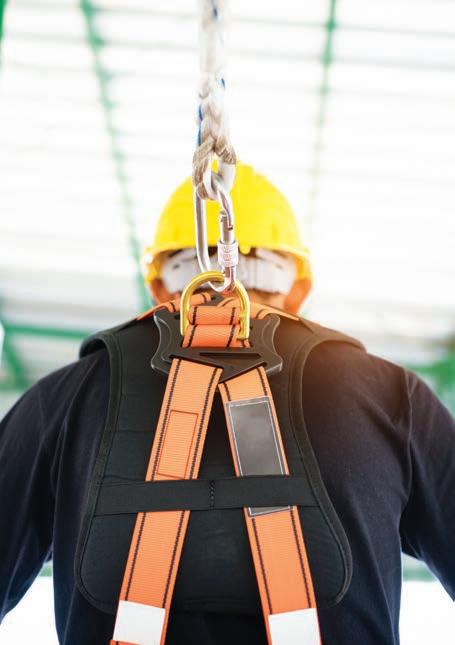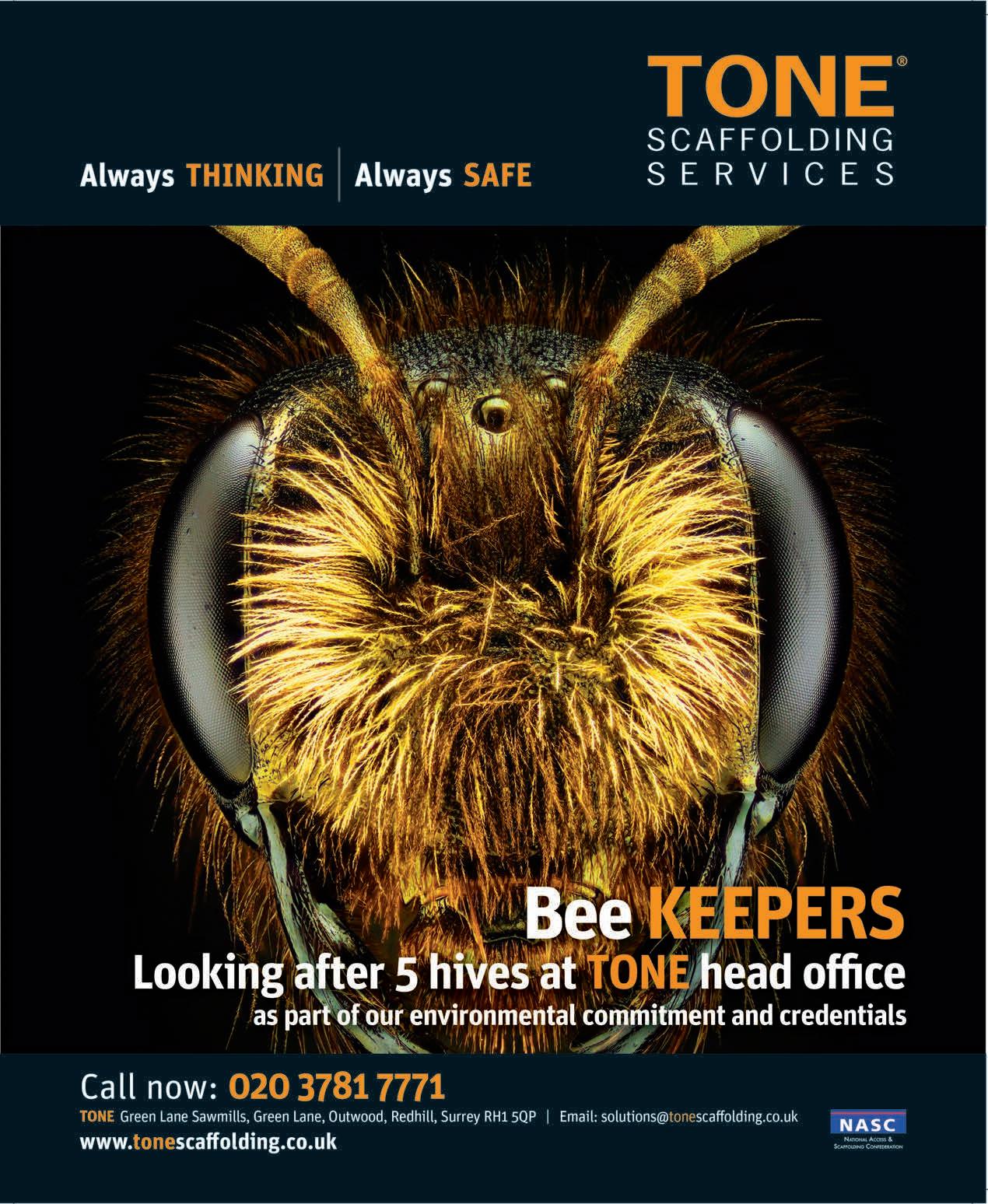
5 minute read
Safety record
INCIDENT REPORT
NASC MEMBERS’ EXCELLENT SAFETY STATISTICS ARE NO ACCIDENT SAYS SIMON ROBINSON
Advertisement
NASC members work to the highest
safety standards. This is evidenced in the annual NASC Safety Report, which charts the number and type of injuries suffered by NASC full contracting member operatives in the previous calendar year.
The latest Safety Report saw injuries fall to a record low – with just 74 incidents reported from a combined workforce of 17,000 scaffolding operatives in 2019. Of these incidents, 13 were recorded as major, requiring hospital treatment, with the remaining 61 recorded as over seven days. These figures are both the lowest on record.
Looking at the total injury figure another way, this meant that over 99% of NASC member-employed operatives went through 2019 accident and injury free. There were also no operative fatalities that year, for the seventh consecutive year.
The Safety Report and its headline figures receive a great deal of attention but less focus is given to how members ensure these numbers are so low. This includes the great lengths members go to in order to make sure their operatives fully buy into safe working practices each and every time they step on site.
It also relies on the NASC’s ongoing commitment to improving safety standards; the creation and dissemination of safety-related toolbox talks; site posters; regular
99%
Roy Rogers, Enigma Industrial Services Ltd
liaison with other bodies such as Build UK and the Health and Safety Executive; and review of NASC Safety Report data to identify ways to further drive injury incidents down.
Safer, more productive
It’s clear that NASC members’ outstanding safety statistics are no accident. We asked NASC members to explain the various steps they take to keep compliance with safety guidance at the forefront of their operatives’ minds while working at height.
Roy Rogers, QSHE & energy director at Enigma Industrial Services Ltd, says: “At Enigma we have developed and implement several proactive procedures to drive cultural change at all levels. These include monitoring behaviour and quarterly campaigns. The Enigma Positive Intervention programme reinforces the company ‘Stop Work’ process, until suitable control measures have been implemented to permit the continuation of work safely. The Positive Intervention Programme provides positive rewards to change unsafe behaviours, reduce job-related injuries, minimise lost production hours, and improve workplace morale – all essential ingredients for creating a strong safety culture.
“Our quarterly campaigns are based on key trends identified through audit, inspection, incidents and/or industry trends. The first two campaigns ‘Get It Right the First Time’, ‘Stop the drop’ and Return to Work 2021 campaigns consisted of a video summarising the campaign and key messages, with a series of posters designed to help further support toolbox talks.
“A video demonstrating the consequences of dropped objects was produced under controlled conditions with an Enigma client. The next campaign will cover Work at Height.”
Helen Gawor, strategy director at GKR Scaffolding Ltd, says ensuring all operatives are working as they should could be a difficult challenge.
“There is no quick answer to this one. We have a health and safety league that means that all sites are rigorously audited on compliance through to behaviour. They get quite competitive. We have things like the virtual reality training but in my opinion, good safe behaviours come down to the level of high-quality supervision. The top sites for safety have better supervision.
“We use basic herd theory from behavioural science: everyone follows the herd. No one wants to be the one doing things differently.”
Digitalising safety
Rob Long, operations directorat Tubes Scaffolding Ltd, says maintaining high safety standards was a balancing act between supervision and trust. “There is a huge element of trust involved. We operate an extensive training programme, with highly experienced, longstanding employees with a great work ethic, and don’t believe in micro managing to get the best out of our teams.
“Our site operatives complete ‘Point Of Work’ risk assessments on every project which will highlight any residual risks and additional controls required. These are in addition to the Risk Assessment Method Statements (RAMS) carried out and are an extensive measure taken to ensure a safe working environment.
“There is a fine line between balancing trust and undermining skillsets. We’re using technology to walk this line.
“We’re continuously monitoring technological advances on safety measures. We are currently improving our reporting process and converting to a digital solution. By developing an app, electronic reports will help to monitor projects, advance communication, automate notifications, provide increased visibility of projects and ultimately enable tighter control.”

Rob Long, Tubes Scaffolding Ltd Dedicated teams
MR Scaffolding Ltd employs a full time health and safety team, headed up by Matthew Trayfoot, H&S director with two managers and two assistant managers.
“Between the team, they ensure that all projects receive a proportionate amount of direct monitoring, with records of site visits recorded via internal auditing processes from which we evaluate our performance," explains Dave Kearney, senior health and safety manager. “Striving for employee ‘buy in’ to cultural changes is a key factor in driving standards ever upwards and we strongly believe that by actively engaging with our workforce they understand our commitment to them.
“MR also employs the services of Simian Risk Management to provide additional compliance monitoring and training of operatives where a needs analysis identifies any requirements. The H&S team assisted by the operations management team also provide pro-active monitoring of all our activities on site and mentor the workforce in best practice and improvements, which are discussed on a regular basis.
“As part of our continual improvement and development, the identification of personal protective equipment plays a significant part of reducing risks to both the company and the individuals. By investing in high quality PPE rather than the cheapest option, which is not always the best or most comfortable to use, the employees are more likely to adopt these changes and see them as a benefit to themselves and not just another company directive.
“We also see investing and researching into new and existing technologies as an overall benefit to the company, such as the introduction of tablets with cloud-based systems for site-based operations, this again is seen by the employees as a good thing as is welcomed from all levels of employees.” ●
Simon Robinson is the NASC marketing manager.
The NASC annual Safety Report is available for free download at https://nasc.org.uk/information/ safety-reports/










